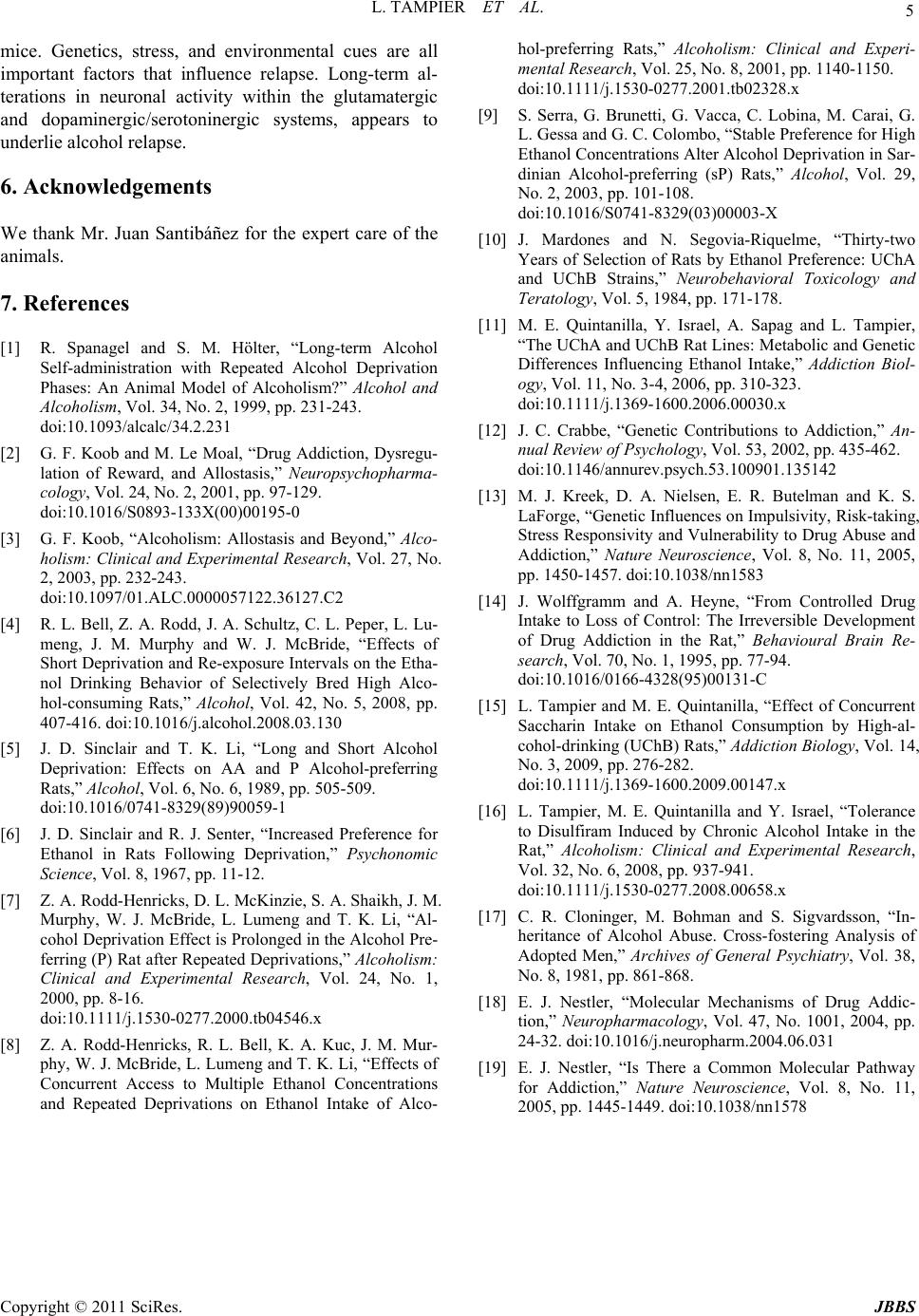
L. TAMPIER ET AL.
Copyright © 2011 SciRes. JBBS
5
mice. Genetics, stress, and environmental cues are all
important factors that influence relapse. Long-term al-
terations in neuronal activity within the glutamatergic
and dopaminergic/serotoninergic systems, appears to
underlie alcohol relapse.
6. Acknowledgements
We thank Mr. Juan Santibáñez for the expert care of the
animals.
7. References
[1] R. Spanagel and S. M. Hölter, “Long-term Alcohol
Self-administration with Repeated Alcohol Deprivation
Phases: An Animal Model of Alcoholism?” Alcohol and
Alcoholism, Vol. 34, No. 2, 1999, pp. 231-243.
doi:10.1093/alcalc/34.2.231
[2] G. F. Koob and M. Le Moal, “Drug Addiction, Dysregu-
lation of Reward, and Allostasis,” Neuropsychopharma-
cology, Vol. 24, No. 2, 2001, pp. 97-129.
doi:10.1016/S0893-133X(00)00195-0
[3] G. F. Koob, “Alcoholism: Allostasis and Beyond,” Alco-
holism: Clinical and Experimental Research, Vol. 27, No.
2, 2003, pp. 232-243.
doi:10.1097/01.ALC.0000057122.36127.C2
[4] R. L. Bell, Z. A. Rodd, J. A. Schultz, C. L. Peper, L. Lu-
meng, J. M. Murphy and W. J. McBride, “Effects of
Short Deprivation and Re-exposure Intervals on the Etha-
nol Drinking Behavior of Selectively Bred High Alco-
hol-consuming Rats,” Alcohol, Vol. 42, No. 5, 2008, pp.
407-416. doi:10.1016/j.alcohol.2008.03.130
[5] J. D. Sinclair and T. K. Li, “Long and Short Alcohol
Deprivation: Effects on AA and P Alcohol-preferring
Rats,” Alcohol, Vol. 6, No. 6, 1989, pp. 505-509.
doi:10.1016/0741-8329(89)90059-1
[6] J. D. Sinclair and R. J. Senter, “Increased Preference for
Ethanol in Rats Following Deprivation,” Psychonomic
Science, Vol. 8, 1967, pp. 11-12.
[7] Z. A. Rodd-Henricks, D. L. McKinzie, S. A. Shaikh, J. M.
Murphy, W. J. McBride, L. Lumeng and T. K. Li, “Al-
cohol Deprivation Effect is Prolonged in the Alcohol Pre-
ferring (P) Rat after Repeated Deprivations,” Alcoholism:
Clinical and Experimental Research, Vol. 24, No. 1,
2000, pp. 8-16.
doi:10.1111/j.1530-0277.2000.tb04546.x
[8] Z. A. Rodd-Henricks, R. L. Bell, K. A. Kuc, J. M. Mur-
phy, W. J. McBride, L. Lumeng and T. K. Li, “Effects of
Concurrent Access to Multiple Ethanol Concentrations
and Repeated Deprivations on Ethanol Intake of Alco-
hol-preferring Rats,” Alcoholism: Clinical and Experi-
mental Research, Vol. 25, No. 8, 2001, pp. 1140-1150.
doi:10.1111/j.1530-0277.2001.tb02328.x
[9] S. Serra, G. Brunetti, G. Vacca, C. Lobina, M. Carai, G.
L. Gessa and G. C. Colombo, “Stable Preference for High
Ethanol Concentrations Alter Alcohol Deprivation in Sar-
dinian Alcohol-preferring (sP) Rats,” Alcohol, Vol. 29,
No. 2, 2003, pp. 101-108.
doi:10.1016/S0741-8329(03)00003-X
[10] J. Mardones and N. Segovia-Riquelme, “Thirty-two
Years of Selection of Rats by Ethanol Preference: UChA
and UChB Strains,” Neurobehavioral Toxicology and
Teratology, Vol. 5, 1984, pp. 171-178.
[11] M. E. Quintanilla, Y. Israel, A. Sapag and L. Tampier,
“The UChA and UChB Rat Lines: Metabolic and Genetic
Differences Influencing Ethanol Intake,” Addiction Biol-
ogy, Vol. 11, No. 3-4, 2006, pp. 310-323.
doi:10.1111/j.1369-1600.2006.00030.x
[12] J. C. Crabbe, “Genetic Contributions to Addiction,” An-
nual Review of Psychology, Vol. 53, 2002, pp. 435-462.
doi:10.1146/annurev.psych.53.100901.135142
[13] M. J. Kreek, D. A. Nielsen, E. R. Butelman and K. S.
LaForge, “Genetic Influences on Impulsivity, Risk-taking,
Stress Responsivity and Vulnerability to Drug Abuse and
Addiction,” Nature Neuroscience, Vol. 8, No. 11, 2005,
pp. 1450-1457. doi:10.1038/nn1583
[14] J. Wolffgramm and A. Heyne, “From Controlled Drug
Intake to Loss of Control: The Irreversible Development
of Drug Addiction in the Rat,” Behavioural Brain Re-
search, Vol. 70, No. 1, 1995, pp. 77-94.
doi:10.1016/0166-4328(95)00131-C
[15] L. Tampier and M. E. Quintanilla, “Effect of Concurrent
Saccharin Intake on Ethanol Consumption by High-al-
cohol-drinking (UChB) Rats,” Addiction Biology, Vol. 14,
No. 3, 2009, pp. 276-282.
doi:10.1111/j.1369-1600.2009.00147.x
[16] L. Tampier, M. E. Quintanilla and Y. Israel, “Tolerance
to Disulfiram Induced by Chronic Alcohol Intake in the
Rat,” Alcoholism: Clinical and Experimental Research,
Vol. 32, No. 6, 2008, pp. 937-941.
doi:10.1111/j.1530-0277.2008.00658.x
[17] C. R. Cloninger, M. Bohman and S. Sigvardsson, “In-
heritance of Alcohol Abuse. Cross-fostering Analysis of
Adopted Men,” Archives of General Psychiatry, Vol. 38,
No. 8, 1981, pp. 861-868.
[18] E. J. Nestler, “Molecular Mechanisms of Drug Addic-
tion,” Neuropharmacology, Vol. 47, No. 1001, 2004, pp.
24-32. doi:10.1016/j.neuropharm.2004.06.031
[19] E. J. Nestler, “Is There a Common Molecular Pathway
for Addiction,” Nature Neuroscience, Vol. 8, No. 11,
2005, pp. 1445-1449. doi:10.1038/nn1578